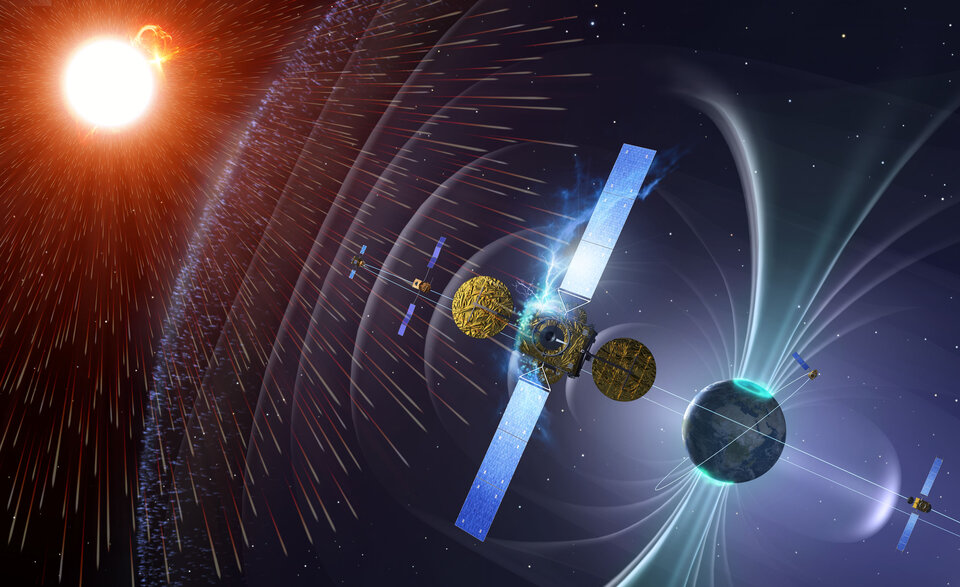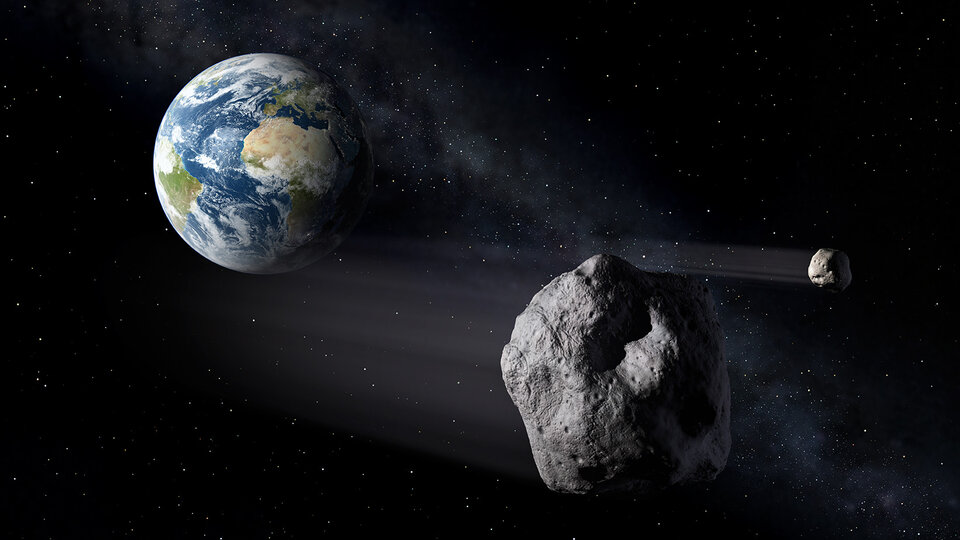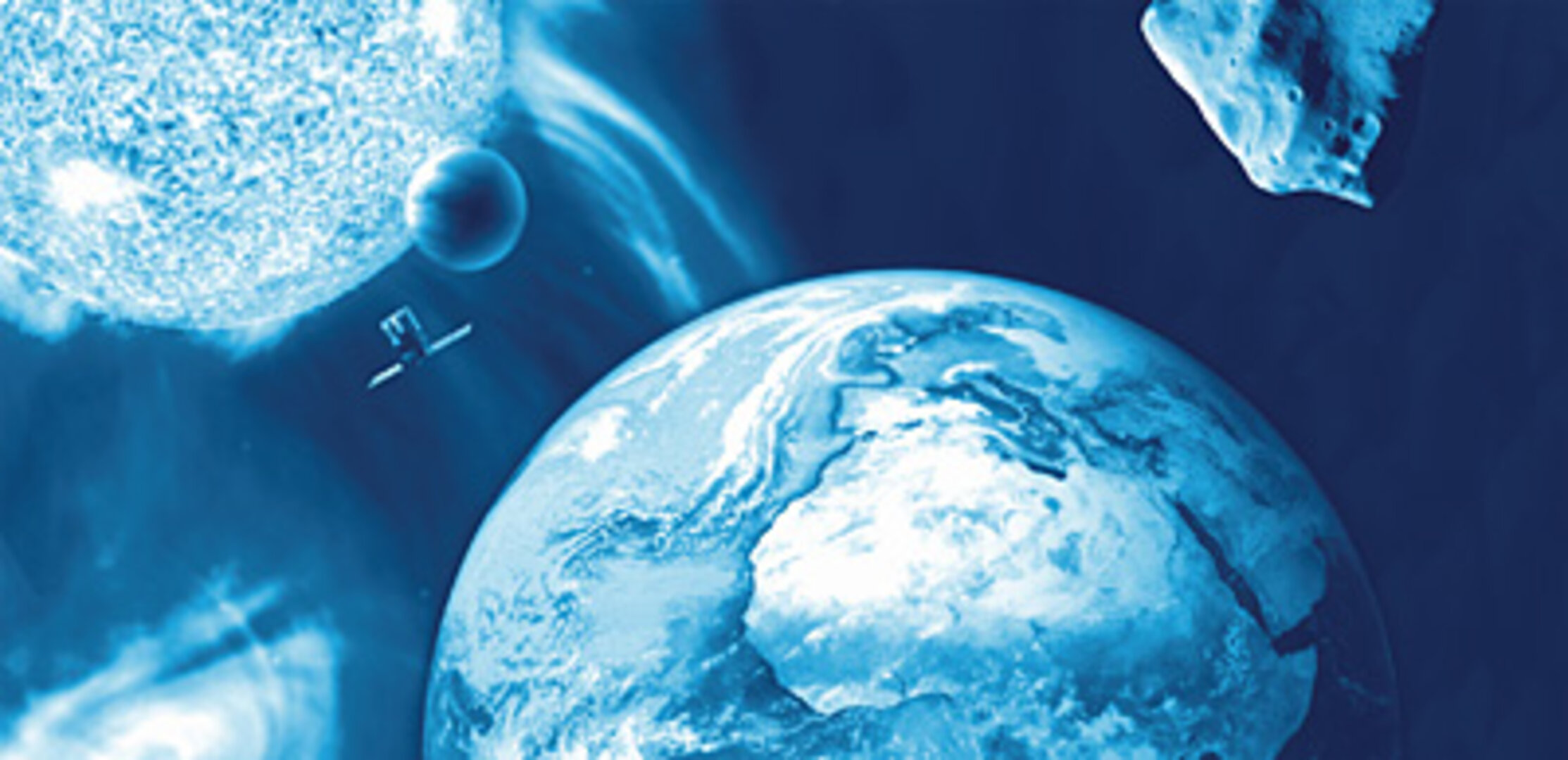SSA Programme overview
The Space Situational Awareness (SSA) Programme is being implemented as an optional ESA programme with financial participation by 19 Member States1. It began in 2009, and the programme’s mandate was most recently extended to 2020 at the 2016 ESA Ministerial Council. The current phase of the programme is funded at €95 million through to 2020.
Under the programme, Europe is acquiring the independent capability to watch for objects and natural phenomena that could harm satellites in orbit or infrastructure such as power grids on the ground. To achieve this, ESA’s SSA programme is focusing on three main areas:
- Space Weather (SWE): monitoring and predicting the state of the Sun and the interplanetary and planetary environments, including Earth’s magnetosphere, ionosphere and thermosphere, which can affect spaceborne and ground-based infrastructure thereby endangering human health and safety
- Near-Earth Objects (NEO): detecting natural objects such as asteroids that can potentially impact Earth and cause damage
- Space Surveillance and Tracking (SST): watching for active and inactive satellites, discarded launch stages and fragmentation debris orbiting Earth
Each of these activities is being developed as ‘segment’ (analogous to a satellite’s traditional ‘ground segment’) in parallel sets of capabilities and services, supported detection and measurement systems, data processing, data centres and end-user/customer support with contributions from existing European infrastructure.
The current activities running to 2020 place increased emphasis on developing space weather and NEO services, while research, development and validation activities continue in the domain of space surveillance and tracking.
The SSA Programme Office is based at ESA’s ESOC Establishment, in Darmstadt, Germany, while technology research and development, project planning and industrial contracting are being conducted by teams located across the Agency, particularly at ESOC, ESRIN and ESTEC, and at European industrial partners.
Developments 2009–12
In addition to on-going technology and system architecture work, significant SSA infrastructure was or is being developed at ESA and partner facilities in several countries, including:
- Set up of the Space Weather Coordination Centre, Space Pole, Brussels, Belgium
- Space Weather Data Centre, ESA Redu Centre, Belgium
- Set up of the NEO Coordination Centre, ESA/ESRIN, Italy
- Establish the Space Surveillance and Tracking Data Centre, ESA/ESAC, Madrid, Spain
- SSA Centre, ESA/ESOC, Darmstadt, Germany
- Development and installation of a monostatic test radar, Santorcaz, Spain
- Development and installation of a bistatic test radar, France
- Initial design of the SSA FlyEye automated telescope to enable full-sky NEO scan
The Space Weather Coordination Centre and NEO Coordination Centre were inaugurated in 2013, and are now providing a growing range of information and data to European customers.
Developments 2013–16
During these years, system development work initiated earlier in the programme continued with the goal of progressively prototyping, developing, testing and validating the main components of the future European SSA system.
In general, activities included:
- Expansion of data and coordination centres
- Enhancement of sensor systems, applications and user interfaces
- Studying the deployment of hosted payloads, e.g. placing space weather sensors on hosting missions
- Expanded utilisation of data from satellites in orbit e.g. Proba-2, SOHO, Gaia, Swarm
- Integrating existing European space-weather infrastructure through the creation of the SSA Space Weather Service Network
- Procurement of instruments having an identified flight opportunity
- Continued Proba-2 mission exploitation
- Studies of an enhanced space weather monitoring system including sensors orbiting Lagrange points L1 and L5
- Precursor services provision and enhancement
- Data Centre maintenance and enhancements
- NEO observation campaigns
- SSA NEO 'FlyEye' wide-field-of-view telescope development
- Asteroid impact mitigation-related studies
- Development of automatic tasking and data-processing functions
- Further development of SST systems
- Test and validation of radar detection techniques
- Development of software tools, applications and data systems
- Research and development in satellite laser ranging
- Research and development in optical surveillance techniques
Planned developments 2017–20
During the current phase of the programme, activities will take place in the following areas:
- Maturing and enhancing space-weather products and services
- Expansion of the Space Weather Service Network with additional European capabilities
- Development of new applications and enhancement of user interfaces
- Development and deployment of sensors
- Deployment of hosted payloads, e.g. placing space weather sensors on hosting missions
- Completing the Phase A/B study for a Lagrange point space weather mission
SWE - Space Weather Segment

Watching our Sun
The objective of the SSA Space Weather Segment is to provide owners and operators of critical spaceborne and ground-based infrastructure timely and accurate information that supports mitigation of the adverse impacts of space weather.
In order to achieve accurate and reliable space-weather services, constant monitoring of the Sun and the space environment from a range of vantage points is needed, together with timely dissemination of reliable data to those needing the information.
Europe already has a wealth of expertise and assets providing high-quality scientific observations, results and models together with a number of space-weather products − processed, usable data − to customers in industry, government and research institutes.
The SSA Space Weather Segment (SWE) is building on this foundation to develop a federated space-weather service-provision concept, avoiding duplication and ensuring that existing assets and resources play a key role in Europe’s Space Weather System.
For more information, access the Space Weather Segment page via http://www.esa.int/ssa-swe
NEO - Near-Earth Object Segment

Coordinating Europe’s role in the global asteroid hunt
Near-Earth Objects (NEOs) are asteroids or comets with sizes ranging from one meter to tens of kilometres that orbit the Sun and whose orbital paths come close to that of Earth's. Of the more than 700 000 known asteroids in our Solar System, about 17 000 are known to be NEOs.
Dramatic proof that any of these can strike Earth came on 15 February 2013, when an unknown object travelling at 66 000 km/hr and thought to be 17-20 m in diameter exploded high above Chelyabinsk, Russia, with 20-30 times the energy of the Hiroshima atomic bomb.
The resulting shock wave caused widespread damage and injuries, making it the largest known natural object to have entered Earth's atmosphere since the 1908 Tunguska event, which destroyed a remote forest area of Siberia.
The major concern with NEOs is the potential threat that they pose to life on our planet, which has been affected numerous times in past eons by impacts.
The good news is that the timescale of the most dangerous events – having major, planetary-scale effects – is extremely long, exceeding not only a human lifetime but the rise and fall of entire civilizations. Nevertheless, even the much more frequent impacts of much smaller bodies are potentially hazardous events and these merit adequate monitoring.
Moreover, NEO monitoring is crucial as our scientific knowledge of the NEO population is still incomplete.
To date, more than 90% of objects with diameters larger than 1 km have been discovered, but this figure drops to only 10% when considering 100 m-sized objects, any one of which would be many times more destructive if they hit Earth than the Tunguska or Chelyabinsk events.
NEO Segment
Goals of the NEO Segment span:
- Expand knowledge of the current and future position of NEOs relative to Earth
- Estimate the likelihood of Earth impacts
- Assess the consequences of any possible impact
- Develop NEO deflection methods
The NEO Segment observes NEOs, predicts their orbits, produces impact warnings when necessary and is involved in potential mitigation measures.
The NEO Segment is based on syndicating and federating Europe’s current observation capabilities and data sources, while developing new sky-survey technologies such as automated telescopes together with a more efficient data and information handling network.
For more information, access the NEO Segment page via http://www.esa.int/ssa-neo
SST - Space Surveillance and Tracking Segment

Monitoring debris objects; warning satellite operators
Space debris are now one of the principle threats to orbiting satellites. It is estimated that an ever-increasing cloud of more than 750 000 dangerous debris objects larger than 1 cm are in Earth orbit with the potential to damage or destroy intact satellites, creating yet more fragments.
In order to mitigate the consequences of space debris, spacecraft operators need to know where the other satellites and fragments are. As part of SSA, ESA is developing and demonstrating the technologies needed to find and track debris and alert satellite operators – who control our vital weather, navigation, telecommunication and science research satellites – when evasive action may be necessary.
Under SSA, Space Surveillance and Tracking (SST) is the ability to detect and predict the movement of space debris in orbit around Earth.
ESA aims at providing the required research and technology development for an autonomous European SST capability in close cooperation with national SST initiatives. One example is the establishment of a cross-national community approach to SST processing and application software, ensuring interoperability and common exchange formats between national SST efforts. The support to national initiatives can also be provided through establishing SST expert centres interfacing with national sensors.
SST Segment
The core activity of the SST Segment addresses a data catalogue containing information on all objects that have been detected in orbit.
Processed measurement data regularly updates that catalogue. Applications using the catalogue data automatically assess the possibility of collisions between the thousands of tracked objects and operational satellites and then, when necessary, issue warnings to satellite controllers.
Another SST application addresses the detection and decay prediction of large pieces of space debris – typically non-functioning satellites or upper stages – that may re-enter the atmosphere and possibly endanger people or infrastructure on ground.
The catalogue can also be used to detect when fragmentations occur in orbit. SST catalogues also help small satellites operators to determine their orbital location and so help scientists exploit lower-cost ‘cubesats’ to conduct valuable research.
For more information, access the SST Segment page via http://www.esa.int/ssa-sst
Partners in SSA
Cooperation with European and international organisations boosts efficiency and effectiveness
An increasing number of European partners and international bodies are contributing their expertise, scientific research capabilities and national services and facilities to SSA. These include in particular:
- Space Weather Centres of expertise across Europe
- Space weather sensor capabilities
- National radar, laser and optical capabilities for NEO and SST
- ESA’s own Optical Ground Station, Tenerife, Spain
- ESA’s test telescopes, one in Cebreros, Spain, and a second one planned for Chile on a site of the European Southern Observatory
- EISCAT research radars
Further, the SSA Programme is working to coordinate the development of Europe’s SSA system with regional and national governments in Europe as well as with the European Union.
The SSA Programme also works routinely with external partners (e.g. USA, South Korea), and with the United Nations. Other international bodies include:
- IAC – International Astronautical Congress and Instituto de Astrofísica de Canarias
- COSPAR – Committee on Space Research
- IADC – Inter-Agency Debris Coordination Committee
- UNCOPUOS-STSC – United Nations Committee on the Peaceful Uses of Outer Space – Scientific and Technical Subcommittee
- ESO – European Organisation for Astronomical Research in the Southern Hemisphere
Participating ESA Member States
SSA is an optional programme.
The following ESA Member States are participating in SSA during the current period, 2017-2020:
| Austria | France | Sweden | Portugal |
| Belgium | Germany | Netherlands | Romania |
| Czech Republic | Greece | Norway | United Kingdom |
| Denmark | Italy | Poland | Switzerland |
| Finland | Luxembourg | Spain |
Budget
SSA has been funded at approximately €200 MEUR, including the two initial periods spanning 2009-2016 and the upcoming period spanning 2017-2020.
The SSA programme is providing strong benefits to European industry.
For example, during its first two periods, over 100 contracts were issued to industry for SSA-related work with a total value in excess of €70 MEUR. In addition, during the current period, a large number of new contracts is foreseen in order to fulfil objectives and progress towards the implementation of a fully functional European SSA System.
Notes:
(1) Since inception of the SSA Programme in 2009, almost all ESA Member states have participated at various times in various activities of the programme.


